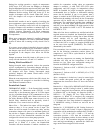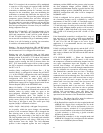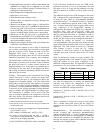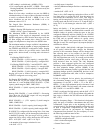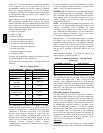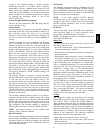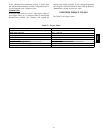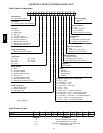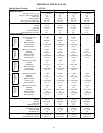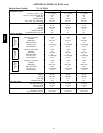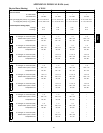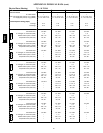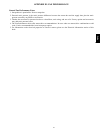
80
the T56 slider offset).
S Space Temperature reading is available.
S If it is unoccupied and the SPT > (unoccupied cool
setpoint plus the T56 slider offset). The indoor fan will be
turned on by the staging algorithm.
S If economizer is available and active and economizer
open > 85% and SAT > (SAT low limit + 5_F) and SPT >
effective setpoint + 0.5_F.
OR
Economizer is available, but not active
OR
Economizer is not available
S OAT > DX Lockout temperature.
If all of the above conditions are met, the compressors
will be energized as required, otherwise they will be
de--energized.
There is a fixed 3--minute minimum on time and a
5--minute off time for each compressor output and a
3--minute minimum time delay between staging up or
down.
Any time the compressors are running the RTU--MP will
stage down the compressors if the SAT becomes less than
the cooling low supply air setpoint.
After a compressor is staged off, it may be started again
after a normal time--guard period and the supply air
temperature has increased above the low supply air
setpoint.
Economize r
The Economizer dampers are used to provide free cooling
and Indoor Air Quality, if optional CO
2
sensor is installed,
when the outside conditions are suitable.
The following conditions must be true for economizer
operation:
S Indoor Fan has been on for at least 30 seconds.
S Enthalpy is Low if the Enthalpy input is enabled.
S SAT reading is available.
S OAT reading is available.
S SPT reading is available.
S OAT <= High OAT economizer lockout configuration
(default = 75).
S OAT <= SPT
If any of the mentioned conditions are not true, the
economizer will be set to its configured minimum
position. The minimum damper position can be
overridden by the IAQ routine described later in this
section.
If the above conditions are true, the Economizer Control
Master Loop will calculate a damper position value based
on the following calculation:
Damper Position = minimum position + PID (SPT -- econ
setpoint). Econ setpoint is half way between the effective
cool and heat setpoints. If the SAT drops below the
cooling low supply air setpoint (+ 5_F), the economizer
will ramp down to minimum position.
Power
Exhaust
If RTU--MP is also controlling an exhaust fan, it can be
enabled based on damper position or by occupancy. If
configured for continuous occupied operation, it will be
energized whenever the controller is in the occupied mode
and disabled when in the unoccupied mode. If configured
for damper position control, it will be energized whenever
the economizer exceeds the power exhaust setpoint and
disabled when the economizer drops below the setpoint by
a fixed hysteresis of 10%.
Heating
The heating outputs are controlled by the Heating Control
PID Loop and Heating Stages Capacity algorithm. They
will be used to calculate the desired number of stages
needed to satisfy the space by comparing the SPT to the
Occupied Heat Setpoint plus the T56 slider offset when
occupied and the Unoccupied Heat Setpoint plus the T56
slider offset if unoccupied. The following conditions must
be true in order for this algorithm to run:
S Indoor Fan has been ON for at least 30 seconds.
S Cool mode is not active and the time guard between
modes equals zero.
S If occupied and SPT <(occupied heat setpoint plus T56
slider offset)
S SPT reading is available
S If it is unoccupied and the SPT < (unoccupied heat
setpoint plus T56 slider offset). The indoor fan will be
turned on by the staging algorithm.
S OAT < High OAT lockout temperature.
If all of the above conditions are met, the heating outputs
will be energized as required, otherwise they will be
de--energized. If the SAT begins to exceed the high supply
air setpoint, a ramping function will cause the Heat Stages
Capacity algorithm to decrease the number of stages until
the SAT has dropped below the setpoint.
There is a fixed one minute minimum on time and a one
minute off time for each heat output. Heat staging has a 3
minute stage up and 30 second stage down delay.
Indoor Air
Quality
If the optional indoor air quality sensor is installed, the
RTU--MP will maintain indoor air quality within the space
at the user configured differential setpoint. The setpoint is
the difference between the indoor air quality and an
optional outdoor air quality sensor. If the outdoor air
quality is not present then a fixed value of 400ppm is
used. The following conditions must be true in order for
this algorithm to run:
S The mode is occupied.
S Indoor Fan has been ON for at least 30 seconds.
S Indoor Air Quality sensor has a valid reading
As air quality within the space changes, the minimum
position of the economizer damper will be changed thus
allowing more or less outdoor air into the space depending
on the relationship of the indoor air quality to the
differential setpoint. If all the above conditions are true,
the IAQ algorithm will run and calculates an IAQ
minimum position value using a PID loop. The IAQ
minimum damper position is then compared against the
user configured economizer minimum position and the
greatest value becomes the final minimum damper
position of the economizer output.
48TC



